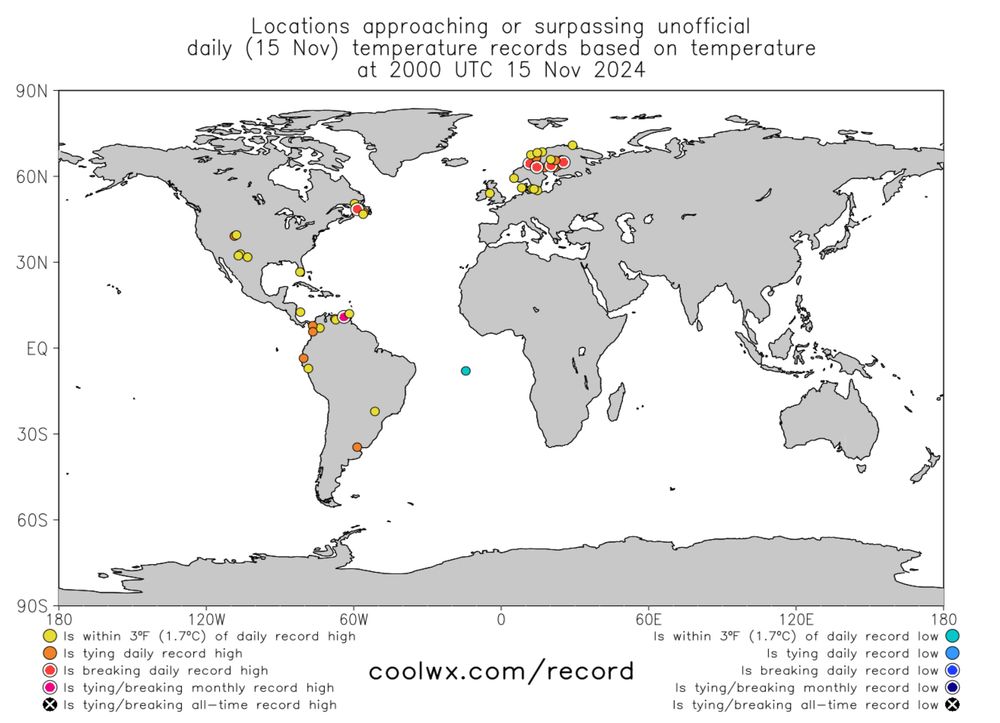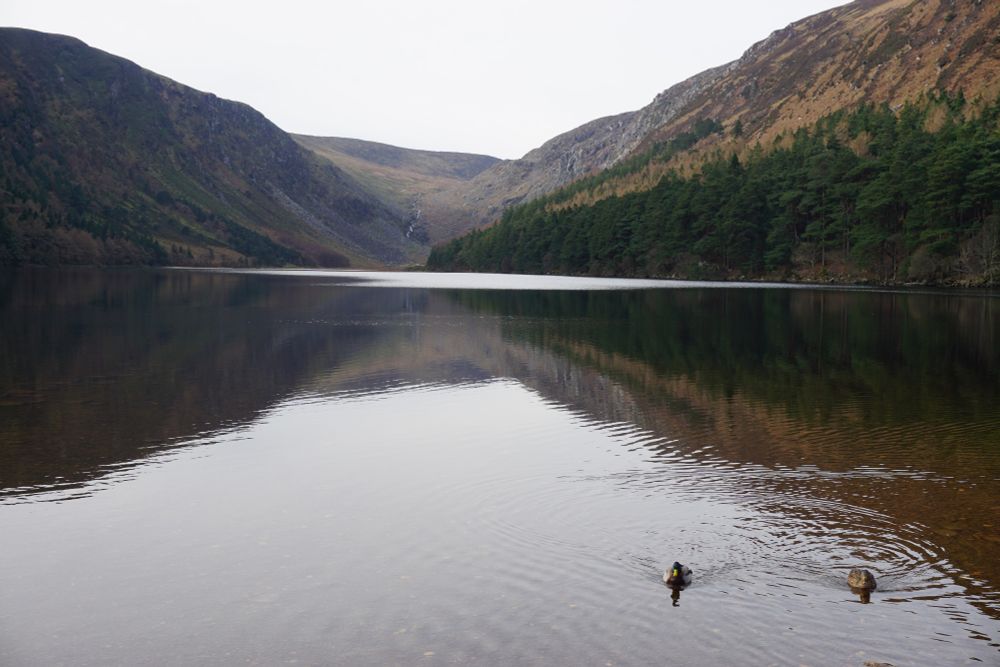

Baffin Bay and the west coast of Greenland currently 20-30°C above average air temperature. Climate means are currently around -25°C for much of this area, but above freezing today past 76°N latitude.
13.03.2025 18:10 — 👍 0 🔁 1 💬 0 📌 0@pakers.bsky.social
Paleoclimatologist, stable isotope geochemist, geographer, stal🪨 and ice🧊 and bog🧌 enthusiast. Assistant professor of physical geography at Trinity College Dublin.


Baffin Bay and the west coast of Greenland currently 20-30°C above average air temperature. Climate means are currently around -25°C for much of this area, but above freezing today past 76°N latitude.
13.03.2025 18:10 — 👍 0 🔁 1 💬 0 📌 0
Clohogue Brook, Wicklow Mountains, Ireland scene
Always nice when your photo quickly snapped to document current conditions when sampling turns out to be a nice photo on its own. Clohogue Brook in the Wicklow Mountains, Ireland.
13.03.2025 15:13 — 👍 4 🔁 1 💬 0 📌 0
Managed to take two precip samples during Éowyn to analyze for water isotopes. Coupled with sampling at two other Dublin sites and our vapor isotope monitor as part of our project ISO-TAISE, we should get some nice insight into the moisture fueling the storm.
25.01.2025 12:41 — 👍 1 🔁 0 💬 0 📌 0
This Met Éireann forecast for the winds on the Aran Islands off Co. Galway and Co. Clare are insane. This feels a bit like when I saw the US National Weather Service forecast a global record high for Death Valley a few years back. You follow the models, but it still feels weird to predict records.
24.01.2025 00:51 — 👍 2 🔁 0 💬 0 📌 0
I feel like this photo on a BBC news update perfectly encapsulates our current society’s approach to fighting climate change, on so many different levels.
09.01.2025 13:26 — 👍 5 🔁 0 💬 0 📌 0
A graph showing some fairly ugly water vapor isotopic data from Dublin.
Our water vapor isotope analyser here in Dublin is still in "test" mode while we get all the specifications fixed, calibrations working properly, and deal with some ongoing inlet condensation issues. But hey, it's still nice to see test data for the past 2.5 months!
19.12.2024 17:55 — 👍 1 🔁 0 💬 0 📌 0
The planet and the U.S. are both running record-warm for the year-to-date period. My monthly global climate summary: yaleclimateconnections.org/2024/12/nove...
12.12.2024 16:49 — 👍 61 🔁 22 💬 1 📌 1Random discovery of the day: my academic great-grandparent is Marjorie Sweeting!
Also, my academic grandparent (Derek Ford) unsuccessfully tried to get posted to Thule, Greenland, and Antarctica early in his career. I managed to stumble into extended projects at both places.
Academia is weird.


As of 9-10 pm local time in many Nordic countries, the reported air temperature is STILL above the old daily record at 5 sites and tied with the record in 6 other sites.
15.11.2024 20:37 — 👍 1 🔁 0 💬 0 📌 0
Upper Glendalough Lake, Wickow Mountains, Ireland.
Oh man, a lot has changed here in the month I've been away. Hello to new followers, and I hope you like seeing field photos of bogs and water in Ireland! Seen here: the glacially formed Upper Glendalough Lake in the Wicklow Mountains, Ireland, only a valley away from one of my main study areas.
14.11.2024 12:13 — 👍 3 🔁 0 💬 0 📌 0Thanks for the interest, and please let me know if you have any questions after reading through the project description. There's of course a lot of details beyond what will fit in a couple of pages!
30.09.2024 16:07 — 👍 1 🔁 0 💬 0 📌 0
Moss, heather, and sedges in an Irish blanket bog.
DRYPEAT is highly interdisciplinary and draws upon the fields of botany, ecology, paleoclimatology, hydrology, and geochemistry. Candidates with a strong interest in the project and with a solid background in one of its components are encouraged to apply through the link above.
30.09.2024 15:42 — 👍 3 🔁 0 💬 1 📌 0
An Irish blanket bog in the Wicklow Mountains.
Irish blanket bogs are critical reservoirs of carbon and biodiversity that are threatened by a warming, drying climate. In DRYPEAT, this postdoc will help develop a new proxy for bog evapotranspiration through isotopic monitoring of a blanket bog's water and plants.
30.09.2024 15:41 — 👍 3 🔁 0 💬 1 📌 0
Lough Tay with blanket bog uplands in the Wicklow Mountains, Ireland.
**Open postdoctoral research position in Irish blanket bog isotopes**
I'm recruiting a postdoc researcher for a 2 year position at Trinity College Dublin to develop isotopic bog drought proxies through our SFI-funded project DRYPEAT. Full details at: naturalscience.tcd.ie/assets/pdf/D...
 10.05.2024 14:53 — 👍 0 🔁 0 💬 0 📌 0
10.05.2024 14:53 — 👍 0 🔁 0 💬 0 📌 0

Rainbow over the River Liffey, Co. Dublin.
All in all, ISO-TAISE will give us an intimate view of the water processes that form and fuel extreme rainfall events, from vapor to precipitation to streams. As our warming world drives stronger extreme events, this knowledge is critical to building a resilient Ireland.
07.03.2024 17:28 — 👍 1 🔁 0 💬 0 📌 0
River swollen with rain runoff in Co. Mayo.
ISO-TAISE culminates in an attempt to intercept a landfalling Irish atmospheric river with field deployment of our vapor isotopic analyser and precipitation sampling. We want to see how moisture dynamics change on the order of minutes during an atmospheric river event.
07.03.2024 17:27 — 👍 0 🔁 0 💬 1 📌 0
TCD Botanical Gardens interior gardens.
So what are getting in ISO-TAISE? We will gather almost four years of continuous water vapor isotope observations from a monitoring site at the TCD Botanical Garden. At the same time, we’ll also be taking samples of Dublin precipitation and stream waters for isotopic analysis.
07.03.2024 17:26 — 👍 1 🔁 0 💬 2 📌 0
EPA Research logo
The funding from EPA Ireland will support the analytical equipment to do the isotopic analyses, as well as PhD and MSc students to perform program research and outreach. Many thanks also to Trinity College Dublin, its School of Natural Sciences, and Geography for supporting the research.
07.03.2024 17:26 — 👍 0 🔁 0 💬 1 📌 0
Rainbow over the Burren, Co. Clare
Atmospheric rivers are corridors of intense water vapor transport that fuel intense storms and rainfall. ISO-TAISE will use the isotopes of water to learn where the moisture and rainfall in Irish atmospheric rivers originates and how it evolves in transport.
07.03.2024 17:24 — 👍 1 🔁 0 💬 1 📌 0
Gorse and heather blooming in the Sugarloafs, Co. Wicklow
🧪 I’m happy to announce that my project ISO-TAISE: Isotopic Tracing of Atmospheric Rivers and Irish Storm Extremes was funded by EPA Ireland as part of their Research Call 2023. This project will gain insight into extreme Irish precipitation events through water isotopes.
07.03.2024 17:24 — 👍 4 🔁 1 💬 1 📌 0This came out before the most recent vote, but it has some of the arguments against it: onlinelibrary.wiley.com/doi/full/10....
Also, I've seen that there's more of a push to consider it a geological event, not era/epoch, since it is an ongoing transformation of the planet.



🧪 What a difference a month makes in the Antarctic summer! The French research station Durmont d'Urville is located on an island, but sea ice lets a supply road connect to the mainland (photo). As of 28 Nov, the sea ice was still intact, but a month later the islands are close to being free again!
31.12.2023 14:06 — 👍 2 🔁 0 💬 0 📌 1Would love to join the feed! Starting back up with this now that the community has grown a bit. peteakers.com and www.tcd.ie/research/pro... are my evidence.
31.12.2023 13:56 — 👍 0 🔁 0 💬 1 📌 0In lieu of a standard report, I gave students the option of doing something creative to express their sensory & emotional impression of our visit in a Mallorca cave. The goal was to explore alternate ways of conveying information not captured by data.
1st submission is a 17 min techno 😆. Let's go!

A tadpole shrimp in a centrifuge vial full of water sampled from a Greenland lake.
Always remember to filter your water samples before geochemical analysis! For example, water isotopic analyzers and ICP elemental analyzers do not handle full grown tadpole shrimp well 😉!
Photo taken in 2019 in Pituffik, Greenland, while on field work examining High Arctic lake isogeochem.

🧪 Having fun with tracking where the moisture that produces precipitation is coming from using HYSPLIT backtrajectory modeling. Here's where the water vapor originated for over 100 precipitation events in Indiana, colored by region and sized by relative contribution to the precipitation.
22.09.2023 16:59 — 👍 0 🔁 0 💬 0 📌 0
🧪 First step to studying where precipitation comes from is to define the source areas! Here's my broad physiographic sources for the NARR model domain. The product of a couple weeks finding, reassigning, & typology fixing online GIS data...& swearing at whoever made the error-filled originals.
21.09.2023 16:22 — 👍 1 🔁 0 💬 0 📌 0People: "Isn't it amazing how animals can tell when storms and natural disasters are coming? We should really pay more attention to them"
Me: "Oh yeah, this one species in particular is amazing at predicting weather!"
*shows them a suite of satellite imagery and supercomputer climate models*

Salix arctica showing yellow autumn color in late August 2018, Pituffik, Greenland.
Autumn comes quick to the Arctic. At Pituffik, Greenland, the sun sets for the first time in four months in the last week of August, then night grows by 20-40 min each day. By mid-September, autumn color has ended (Arctic willow seen here in late August) and soon everything refreezes until next May.
06.09.2023 12:33 — 👍 0 🔁 0 💬 0 📌 0